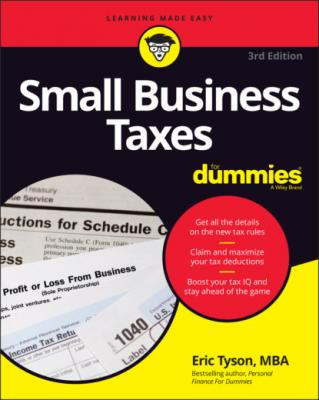Small Business Taxes For Dummies. Eric Tyson
Чтение книги онлайн.
Читать онлайн книгу Small Business Taxes For Dummies - Eric Tyson страница 17
 should you rush out and incorporate in one of these corporate-friendly states if you live in one of the other 47 states? The answer is probably not. The reason is that the state in which you operate your company probably also requires you to register your corporation and pay the appropriate fees and taxes.
should you rush out and incorporate in one of these corporate-friendly states if you live in one of the other 47 states? The answer is probably not. The reason is that the state in which you operate your company probably also requires you to register your corporation and pay the appropriate fees and taxes.
You should also consider the fact that some folks with whom you do business may be puzzled or concerned by your out-of-state incorporation. If you’re considering incorporating out of state, you should definitely consult with an experienced small-business legal advisor and tax advisor.
Corporations also offer continuity of life, which simply means that corporations can continue to exist despite the death of an owner or the owner’s transfer of their share (stock) in the company.
Knowing where to get advice
If you’re totally confused about whether to incorporate because your business is undergoing major financial changes, getting competent professional help is worth the money. The hard part is knowing where to turn because finding one advisor who can put all the pieces of the puzzle together can be challenging. And be aware that you may get wrong or biased advice.
One step further: S corporations
Subchapter S corporations, so named for that part of the tax code that establishes them, offer some business owners the best of both worlds. You get the liability protection that comes with being incorporated as with a C corporation, and the business profit or loss passes through to the owner’s personal tax returns (like in a sole proprietorship). In this section, I discuss the tax specifics of using S corporation status and the requirements for S corporations.
S corporation tax specifics
An S corporation is known as a pass-through entity for tax purposes. This simply means that the income that the company earns passes through to the company’s owner/shareholders and is taxed at each person’s individual level.
So if the business shows a loss in some years, the owners/shareholders may claim those losses in the current year of the loss on their tax returns against other income earned. This is potentially useful in the early years of a new business, a time when most companies lose money. To be able to claim losses, you must “materially participate” in the business, which generally means that you actively work in the company at least 500 hours per year, although 100 hours will suffice if that’s the most among all other shareholders.
If, like most businesses, the company becomes profitable, it may actually make sense then to convert back to a regular C corporation to partake of the potential advantages of that status. That includes being able to retain earnings in the company, which you can’t do with an S corporation, and being able to use tax-advantaged fringe benefits. (If you plan to take all the profits out of the company, an S corporation may make sense for you.)
Even though the corporation doesn’t pay federal income tax, the company must annually complete and file IRS Form 1120S — “U.S. Income Tax Return for an S Corporation” (see the first page of the form in Figure 2-2; the complete form is located at www.irs.gov/pub/irs-pdf/f1120s.pdf). Also, some states levy a state income tax on S corporations, and many states require paying an annual fee.
Courtesy of the Internal Revenue Service
FIGURE 2-2: Page one of IRS Form 1120S, “U.S. Income Tax Return for an S Corporation.”
S corporation requirements
All corporations actually begin as so-called C corporations, which are the corporations discussed in the section “Deciding whether to incorporate” earlier in this chapter. To become an S corporation, your business must go through an additional “tax election” step. See IRS Form 2553, “Election by a Small Business Corporation.”
U.S. tax laws allow most, but not all, small businesses to be taxed as an S corporation. To be an S corporation in the eyes of the almighty IRS, a company must meet all the following requirements:
Be a U.S. company
Have just one class of stock
Have no more than 100 shareholders who are all U.S. residents or citizens and aren’t partnerships, other corporations, or, with certain exceptions, trusts
Partnerships
A partnership occurs in the eyes of the tax authorities when two or more people — the general partners (GPs) — operate a business together and divide the profits (or losses). The division need not be done equally.
The GPs are responsible for the company’s debts and liabilities. A partnership may also have limited partners (LPs) who generally provide financing to the business and who aren’t active in the company itself.